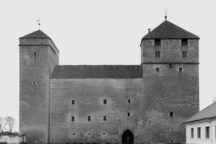Arne Maasik, b 1971, is one of the most influential architectural photographers in Estonia. He has participated in long-term projects involving large-scale research and had numerous solo exhibitions in Rome, Venice, Berlin, Moscow, Budapest, Helsinki, Tallinn and elsewhere. Arne Maasik’s work is characterized by an awareness of metaphysical undercurrents and muted poetry.
www.arnemaasik.org
Heie Marie Treier, PhD, b 1963, is an art historian and art critic lecturing at the Baltic School of Film, Media, Arts and Communication of Tallinn University. Her dissertation was on the topic of Early Modernist painting and Karl Pärsimägi (1901-1942), who died in Auschwitz. As the editor-in-chief of kunst.ee magazine in 2000-2007, she participated in the Documenta magazine project in Kassel, Germany in 2007. This project is the outcome of a long-term research process and dialogue with American and Estonian intellectuals.
heie@tlu.ee
Martin Pedanik, b 1974, is a graphic designer and artist, author of the KAHN. Bold typeface (2016-2018), and member of the Tallinn-based Kahn. Islander research group since 2007. Pedanik was the co-founder and graphic designer of the avant-garde Theater NO99 in Tallinn from 2005 to its closing in 2019, and the co-author of the Estonian Pavilion at the 2010 Venice Architecture Biennale.
www.labor.ee
After the end of the Cold War, architect Anne Tyng was one of the first Kahn experts to visit Saaremaa in 1993, at a time when most of the former Soviet military personnel had left the island and it was once again open to foreigners.
The roots of the current Tallinn-based research platform entitled Kahn. Islander go back to 2006, when the Estonian Association of Architects held the first Louis Kahn Days at Kuressaare Bishop’s Castle. It drew a great many specialists in the field of architecture and engineering from Estonia as well as Kahn scholars from the US. Kahn’s family members Anne Tyng, Alexandra Tyng, Becca Tyng and Nathaniel Kahn also made the trip from the states.
Nathaniel Kahn planted the original seed for the research project, which spanned many years and progressed slowly. At the time, the Baltics lacked a tradition of Kahn scholarship. However, the Cold War period really did not end in terms of Kahn studies until the 2006 Kahn Days were held in Saaremaa.
At first, it seemed that there was nothing new to learn about Kahn’s earlier life due to the destruction that the two world wars had wrought. Yet small pieces of a mosaic could nevertheless be collected and arranged in the right places.
The research platform’s core members are three figures representing different disciplines and motivated by intellectual curiosity and a bit of defiance. Art historian and critic Heie Marie Treier, PhD, studies the topic’s textual background, examining publications, such as the latest studies on medieval Estonian architecture and Kahn studies. Architect and photographer Arne Maasik performs comparative visual analysis with his camera, proceeding from a certain method and informed by the textual research. For his part, graphic designer Martin Pedanik gives the Kahn exhibitions and publications a visual identity. He has also developed the prototype for a new font – Kahn. Bold.
Their efforts are supported by the Louis Kahn Estonia Foundation established at the Estonian Association of Architects and the foundation director Ott Rätsep.
Close collaborators include interpreter Juta Ristsoo, Estonian Association of Architects manager Ingrid Mald, and the architects Mikk Mutso and Toivo Tammik. Architect Vilen Künnapu has also served in an advisory role. The young architect Kaspar Stroom recently collaborated with the group. The group is in dialogue with the architecture scholar Carl-Dag Lige, who studies the structural engineer August Komendant. In New York, the group engages in close cooperation with the Cultural Affairs Coordinator of Estonia, artist Jaanika Peerna and the philosopher David Rothenberg. Dialogue also continues with Kahn scholars and Kahn’s relatives in the US.
The research project was made possible thanks to generous support from the Cultural Endowment for Estonia.
Louis Kahn Estonia Foundation
Tallinn, Estonia
contact (a) louiskahn.org
www.facebook.com/louiskahnestonia
